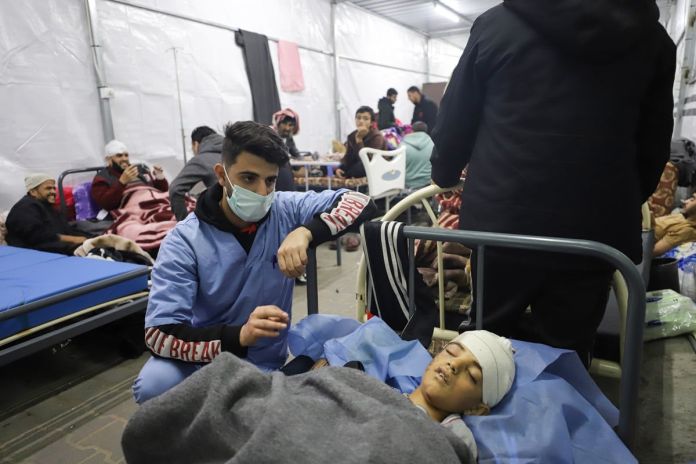- New mass displacement of Palestinians fleeing fighting, health facilities crammed with people seeking refuge, food
GAZA CITY, Gaza – World Health Organization teams have undertaken high-risk missions to deliver supplies, with partners, to hospitals in Northern and Southern Gaza witnessing intense hostilities in their vicinity, high patient loads and overcrowding caused by people displaced by the conflict seeking refuge.
“Today, I repeat my call on the international community to take urgent steps to alleviate the grave peril facing the population of Gaza and jeopardizing the ability of humanitarian workers to help people with terrible injuries, acute hunger, and at severe risk of disease,” said Dr Tedros Adhanom Ghebreyesus, WHO director-general.
In WHO’s latest high-risk mission, teams visited on Tuesday 26 December two hospitals – Al-Shifa in the north and Al-Amal Palestine Red Crescent Society in the south – to deliver supplies and assess needs on the ground.
Both hospitals also serve as shelters for displaced people seeking relative safety. At Al-Shifa Hospital, a reported 50, 000 people are sheltering, while in Al-Amal there are 14, 000.
At Al-Shifa, WHO delivered fuel to keep essential health services running. With UNICEF, WHO also delivered medical supplies for the hospital. And in support of NGO partner, the World Central Kitchen, delivered materials to support a kitchen at Al-Shifa. Medical supplies were also delivered to the Gaza Central Drug Store, which will act as a medical supply hub to deliver to other hospitals, and will be supported by WHO and partners.
At Al-Amal, colleagues saw the aftermath of recent strikes that disabled the hospital’s radio tower and impacted the central ambulance dispatch system for the entire Khan Younis area affecting more than 1.5 million people.
Of the nine ambulances the hospital once had, only five remain functioning. WHO staff reported finding it impossible to walk inside the hospital without stepping over patients and those seeking refuge. There are only few functioning toilets available in the hospital and adjacent community buildings and PRCS training centres for the people taking refuge there, staff and hospital patients.
While transiting across Gaza, WHO staff witnessed tens of thousands of people fleeing heavy strikes in the Khan Younis and Middle Area, on foot, riding on donkeys, or in cars. Make-shift shelters were being built along the road.
“WHO is extremely concerned this fresh displacement of people will further strain health facilities in the south, which are already struggling to meet the population’s immense needs,” said Dr Rik Peeperkorn, WHO representative in WHO’s office for the West Bank and Gaza. “This forced mass movement of people will also lead to more overcrowding, increased risk of infectious diseases, and make it even harder to deliver humanitarian aid.”
According to the latest WHO assessments, Gaza has 13 partially functioning hospitals, two minimally functioning ones, and 21 that are not functioning at all.
Among these is Nasser Medical Complex, which is the most important referral hospital in Southern Gaza, and is partially functioning. Recent reports of residential areas being ordered to evacuate around the hospital are extremely concerning.
“When military activities intensify near the hospital, ambulances, patients, staff, and WHO and partners will be unable to reach the complex, and this key hospital will quickly become barely functional,” said Dr Peeperkorn.
“This scenario was witnessed all too often in the North. Gaza can not afford to lose any more hospitals. WHO is working to strengthen and expand the existing struggling health system.”
WHO staff also reported Tuesday that the need for food continues to be acute across the Gaza Strip. Hungry people again stopped our convoys today in the hope of finding food.
WHO’s ability to supply medicines, medical supplies, and fuel to hospitals is being increasingly constrained by the hunger and desperation of people en route to, and within, hospitals we reach.
“The safety of our staff and continuity of operations depends on more food arriving in all of Gaza, immediately. My own colleagues are also being directly and personally affected by the conflict, just like virtually everyone in Gaza. I continue to receive heartbreaking news of the loss of our Gaza staffers’ family members,” Dr Tedros said.
“The recent United Nations Security Council resolution appeared to provide hope of an improvement in humanitarian aid distribution within Gaza,” Dr Tedros added. “However, based on WHO eyewitness accounts on the ground, the resolution is tragically yet to have an impact. What we urgently need, right now, is a ceasefire to spare civilians from further violence and begin the long road towards reconstruction and peace.”





